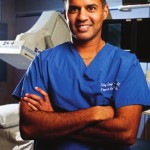Back problems common in workplace | The Pain Doctor » Dr. Ebby G. Varghese
by COMO Staff
May 27, 2011

Low back pain affects virtually everyone at some point in their life regardless of their activity or work. It is important to understand when you suffer from back pain why it happens and what can be done about it.
Volumes can be written about low back pain, but let’s start with some basic knowledge about the back itself:
• The spine is built with 33 bones. The neck (or cervical spine) has seven; the mid-back (or thoracic spine) has 12; the lumbar spine (or low back) has five; the tailbone, comprised of the sacrum and the coccyx, contains five fused bones of the sacrum and four bones of the coccyx.
• In between the spine bones (or vertebral bodies) are the discs of the spine. They are the shock absorbers of the upper body that cushion the back bones while we are active. In a healthy spine, the discs typically carry 80 percent of the body weight. The final 20 percent are carried on the joints of the spine. These joints are called facet joints. They connect one vertebral body to another. The bony spine creates a protective cage around the spinal cord.
• The spine also allows access for the nerves to run from that spinal cord out to your arms and legs. The discs, the facet joints, the nerves and of course the muscles surrounding the spine are common pain generators.
When someone complains of low back pain, he or she is typically referring to the lumbar spine and sacrum. The sacrum is not technically part of the spine but rather the pelvis. The pelvis creates the bony ring that your organs sit in and your legs attach to.
Over time depending on your genetics, obesity, smoking, activity, work, trauma or previous surgery, different areas of your spine can break down. Common problems are disc degeneration, arthritis of the small joints of the spine called facet arthrosis (also called spondylosis), sacroiliac joint pain (this is the joint between the sacrum and the hip bones of the pelvis), pinched nerves at the level of the spine and muscle spasms.
It is estimated that 100 million work days are lost each year to low back pain. This is estimated to cost employers $20 billion. Each state has its own rules for determining if the back pain was a pre-existing condition or actually a true work injury. Whether the back pain was recognized at work, early diagnosis and treatment will help get you back to your life and hopefully prevent chronic pain.
It is important that you know the employee health policies of your workplace. If your back pain is severe enough, you should seek help immediately. In the first four weeks of the injury, there typically is no need for immediate X-rays or advanced imaging. Work restrictions, non-narcotic pain medication and physical therapy are generally the common pathways of treatment, and 90 percent of back pain will resolve within that time. For low back pain serious enough to prevent any work or physical therapy, injections and sometimes surgery might be necessary.
If imaging is necessary, it is important to realize that depending on how advanced the imaging is, various pain generators may be identified, but keep in mind that not all of these factors are actually causing the pain. Many times I have patients who come in and tell me they have a bulging disc or a pinched nerve because their imaging says so; however, the patient does not describe symptoms consistent with those problems. Care providers are obligated to treat the patient not the imaging, unless the problem identified on imaging is consistent with the patient’s examination findings.
I encourage employers to develop a plan for work injuries. Physicians can be contracted to employers to see workers immediately and start aggressive management. Larger companies typically have an employee health office on site where workers can go to address their injuries. In any situation, the earlier the treatment is employed the better.
Dr. Ebby G. Varghese is the medical director at the Interventional Pain Medicine Clinic and assistant professor of clinical physical medicine and rehabilitation in the Department of Physical Medicine and Rehabilitation at the University of Missouri.


